On a recent visit to Temagami my wife M and I dropped by the Temagami Canoe Co. I parked around the side and walked up to the open front door. I stepped just inside and called "Hullo!" but got no response. I could see through to the shop in back there was someone about. I didn't want to be so bold as to walk straight through so I strolled around to the the side door past tall grass and wildflowers. Inside I found a young couple painting an upturned wood/canvas boat. I introduced ourselves and asked if I could meet the builder himself if he wasn't too busy, or maybe just be allowed to walk around. I wouldn't touch anything, I promised. She smiled and told me her dad would love to talk canoes and stuff, and that he was around somewhere and that he was a character. I asked the obvious "So, you do square sterns too?" She laughed and spread her arms out wide holding paintbrush and roller "We do everything here!" The marine paint smelled strong and was the colour of sea foam. I hated to ask if that was the final colour or just a base coat. Just then John stepped into the doorway and leant against the weathered frame. We made our introductions and I explained I'd spent some summer and winter holidays here on the lake and in town, but that was long ago. I'd fallen out of touch with family here and the town. He smiled and dove right in, filling me in on all the comings and goings of the town and region over the past 30 years. And then he led us through to the old shop where he gave us a full tour.
John Kilbridge bought the business along with his brother in 1977 from the founder Bill Smith, who had started the canoe company in 1928-29. That makes Temagami Canoe Co the oldest canoe shop in Ontario and the second oldest in Canada. The shop was dimly lit, but I could see big heavy machinery lurking in the shadows. The table saw is nearly 5 feet by 6 feet and solid cast steel. He showed me the other units, all equally robust, and all retired from work. He pointed to the Crossley power plant sitting in the corner. It seems someone long ago tried to rebuild it but lost the head plate. John said it'd take a small fortune to machine a replacement, so it remained idle. They once cut their own timber in the area to build their canoes, but nowadays outsourced all the materials. Next I saw his pride and joy, a 2 blade planer. John held up a freshly made rib and pointed out the chatter marks the old 2 blade left. "I like the hand hewn look of that. Not too smooth and polished." I agreed. It had character, just like everything in the shop. The enormous steam boiler needed an expensive overhaul, so it sits "as the world's biggest paperweight" John called it. We talked paint, and mourned the loss of lead based paints. "You can't get an intense vibrant red anymore, and the modern stuff is too thin; the greens are muddy now. And those are the iconic colours of these canoes, especially red." John still uses lead based filler, the recipe he avoided telling me. "Nothing like lead as a preservative. I flame the canvas before filling to eliminate fuzz. Reduces the rubbing and sanding work, but it's still lots of work. I get regular check-ups. The doc says I'm in great shape and my lungs are clear. I take care with what I do." I admired the fine fitting of an inside stern piece and asked if he replaced full ribs all the time. Nearly half the ribs had been replaced in the 16' Temagami model in a cradle. He explained he didn't just repair and restore, but also improved past mistakes made from the previous builder. He showed me some planking seams that failed the 2-2 rule. "2 ribs over and 2 planks down. Never any closer to keep the strength and integrity." I admired the deck and asked if that were the defining signature of any canoe. John said no, that there are several design features of every maker and model. problem is he said, most plans have been thrown away over the years. Few builders thought to preserve their designs on paper, much less their alterations. As an example he showed me a bow being rebuilt. It apparently had been rebuilt decades before, but not to the original canoe design. John had to research that model and date to find the correct stem profile, build his own jigs, and then rebuild the bow according to original authenticity. "I'm fussy that way. Everything is in the details."
He only uses full length red cedar (IIRC) for the gunnels. No scarfing. He was as evasive with his lumber and leather sources as his recipes. He showed me leather tumps for the canoes, and explained he considered the Temagami carry bar and tump to be the best portage method for these old w/c canoes. "You carry the load off your shoulders with a straight back, just like tumping a heavy pack. All the weight gets transferred down to your hips and legs, never your shoulders and back. And you can shift it for uphill or downhill." I asked about the treasure trove of various shapes and sizes of kindling placed in the rafters above our heads, some pieces marked in heavy pencil with dates and names. "Oh yeah, that's my archive. Gotta keep records." I found a thwart dated 1961.
John has a backorder of restorations, so I asked about his new builds. Could I see one? "Oh, those don't last around here for me to show off. As soon as I'm done they're out the door." But he is expecting to trim some more "plastic canoes" made by another builder he likes and respects. "I checked him out. I like him. He's just like me, a detail guy and real fussy." John offered to take me up to an outfitter where there's some of their canoes on show, but I was running late. I promised to take him up on his offer if he had the time, next time I was around. I can't wait to keep that promise.
Standing outside he laughed and pointed to the old weathered clapboard "You can look at that till you go cross-eyed, and you'll not find a single clear board. He probably used up all the knotty boards to build this place, and kept the clear ones for canoes." The old shop is still standing, full of saw dust, boards, archives and treasure. If you want to take a step back in time with a man generous with his knowledge and his time I'd suggest a visit to John's shop. Oh, and he's planning on "getting into making paddles." Again, he didn't exactly answer my question where he was sourcing his material. He stepped through a cluttered pile of shavings and wood to reach for a beavertail. Demonstrating just the right amount of flex he said "Now that has life in it!" "If you're really gonna be gentle with resources and a conservationist, wouldn't you rather take good care of these finely crafted pieces, rather than treating them like throwaway consumer junk? I make things to last a lifetime. Not sure if there'll be another generation to get into this; I sure hope so. There's pride and skill in every board, rib and paint job."
John Kilbridge bought the business along with his brother in 1977 from the founder Bill Smith, who had started the canoe company in 1928-29. That makes Temagami Canoe Co the oldest canoe shop in Ontario and the second oldest in Canada. The shop was dimly lit, but I could see big heavy machinery lurking in the shadows. The table saw is nearly 5 feet by 6 feet and solid cast steel. He showed me the other units, all equally robust, and all retired from work. He pointed to the Crossley power plant sitting in the corner. It seems someone long ago tried to rebuild it but lost the head plate. John said it'd take a small fortune to machine a replacement, so it remained idle. They once cut their own timber in the area to build their canoes, but nowadays outsourced all the materials. Next I saw his pride and joy, a 2 blade planer. John held up a freshly made rib and pointed out the chatter marks the old 2 blade left. "I like the hand hewn look of that. Not too smooth and polished." I agreed. It had character, just like everything in the shop. The enormous steam boiler needed an expensive overhaul, so it sits "as the world's biggest paperweight" John called it. We talked paint, and mourned the loss of lead based paints. "You can't get an intense vibrant red anymore, and the modern stuff is too thin; the greens are muddy now. And those are the iconic colours of these canoes, especially red." John still uses lead based filler, the recipe he avoided telling me. "Nothing like lead as a preservative. I flame the canvas before filling to eliminate fuzz. Reduces the rubbing and sanding work, but it's still lots of work. I get regular check-ups. The doc says I'm in great shape and my lungs are clear. I take care with what I do." I admired the fine fitting of an inside stern piece and asked if he replaced full ribs all the time. Nearly half the ribs had been replaced in the 16' Temagami model in a cradle. He explained he didn't just repair and restore, but also improved past mistakes made from the previous builder. He showed me some planking seams that failed the 2-2 rule. "2 ribs over and 2 planks down. Never any closer to keep the strength and integrity." I admired the deck and asked if that were the defining signature of any canoe. John said no, that there are several design features of every maker and model. problem is he said, most plans have been thrown away over the years. Few builders thought to preserve their designs on paper, much less their alterations. As an example he showed me a bow being rebuilt. It apparently had been rebuilt decades before, but not to the original canoe design. John had to research that model and date to find the correct stem profile, build his own jigs, and then rebuild the bow according to original authenticity. "I'm fussy that way. Everything is in the details."
He only uses full length red cedar (IIRC) for the gunnels. No scarfing. He was as evasive with his lumber and leather sources as his recipes. He showed me leather tumps for the canoes, and explained he considered the Temagami carry bar and tump to be the best portage method for these old w/c canoes. "You carry the load off your shoulders with a straight back, just like tumping a heavy pack. All the weight gets transferred down to your hips and legs, never your shoulders and back. And you can shift it for uphill or downhill." I asked about the treasure trove of various shapes and sizes of kindling placed in the rafters above our heads, some pieces marked in heavy pencil with dates and names. "Oh yeah, that's my archive. Gotta keep records." I found a thwart dated 1961.
John has a backorder of restorations, so I asked about his new builds. Could I see one? "Oh, those don't last around here for me to show off. As soon as I'm done they're out the door." But he is expecting to trim some more "plastic canoes" made by another builder he likes and respects. "I checked him out. I like him. He's just like me, a detail guy and real fussy." John offered to take me up to an outfitter where there's some of their canoes on show, but I was running late. I promised to take him up on his offer if he had the time, next time I was around. I can't wait to keep that promise.
Standing outside he laughed and pointed to the old weathered clapboard "You can look at that till you go cross-eyed, and you'll not find a single clear board. He probably used up all the knotty boards to build this place, and kept the clear ones for canoes." The old shop is still standing, full of saw dust, boards, archives and treasure. If you want to take a step back in time with a man generous with his knowledge and his time I'd suggest a visit to John's shop. Oh, and he's planning on "getting into making paddles." Again, he didn't exactly answer my question where he was sourcing his material. He stepped through a cluttered pile of shavings and wood to reach for a beavertail. Demonstrating just the right amount of flex he said "Now that has life in it!" "If you're really gonna be gentle with resources and a conservationist, wouldn't you rather take good care of these finely crafted pieces, rather than treating them like throwaway consumer junk? I make things to last a lifetime. Not sure if there'll be another generation to get into this; I sure hope so. There's pride and skill in every board, rib and paint job."
Attachments
-
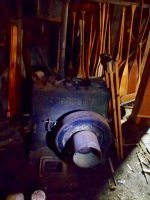 photo7993.jpg79.1 KB · Views: 0
photo7993.jpg79.1 KB · Views: 0 -
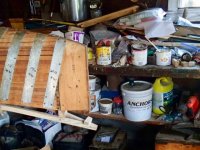 photo7994.jpg88.7 KB · Views: 0
photo7994.jpg88.7 KB · Views: 0 -
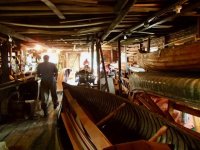 photo7995.jpg118.7 KB · Views: 0
photo7995.jpg118.7 KB · Views: 0 -
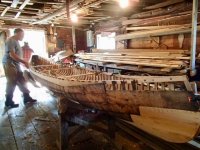 photo7996.jpg96.7 KB · Views: 0
photo7996.jpg96.7 KB · Views: 0 -
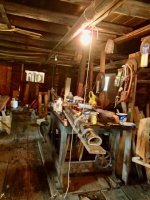 photo7997.jpg119.9 KB · Views: 0
photo7997.jpg119.9 KB · Views: 0 -
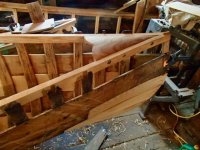 photo7998.jpg117.8 KB · Views: 0
photo7998.jpg117.8 KB · Views: 0 -
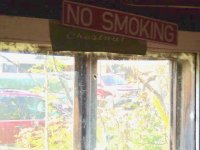 photo7999.jpg110.5 KB · Views: 0
photo7999.jpg110.5 KB · Views: 0 -
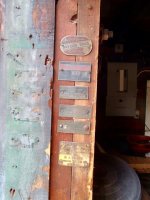 old canoe plates.jpg80.7 KB · Views: 0
old canoe plates.jpg80.7 KB · Views: 0 -
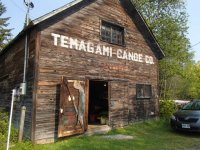 photo8001.JPG98.9 KB · Views: 0
photo8001.JPG98.9 KB · Views: 0
Last edited:
